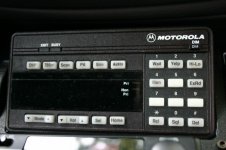Hi All,
New here, nice site! I’m not new to forums etc. I am on quite a few automotive forums (some as long as over 25yrs now) and came across this site while trying to search out information I need for a restoration project I’m working on. I was not sure if this would be better posted in the Motorola sub-forum on here, or this Texas sub-forum. So I posted here because my quest is “Texas” related and thought this audience may have better insight. I’m restoring a DPS patrol car to period correct as it was in-service. I need help with the Motorola Syntor system if anyone knows about what they used back in the 90’s or can assist with pointing me in the right direction. I’m also a member over on elightbars, but there is not a lot of activity there.
I had sent an email to TX Fleet Services but didn’t get much help since they don’t have any records left from the period due to record retention policies.
Here is what I know:
- in the 90’s TX used the Motorola Syntor system; it was the VHF version
- front Motorola control head (A9 or W9?) controlled the siren and was also the “radio”
- in the trunk there was the Motorola radio “brick” and the siren brick
What I need help with is I need to find the period correct:
- Motorola Syntor radio brick
- Motorola Siren brick
- correct cables for control head, radio brick, and siren brick
I know these components are on eBay and other sites, but I don’t want to just buy blindly (and end goal is to get the equipment to function). I’ve tried going through the info on “repeater-builder” site and even looking through old Motorola pdf manuals. The problem is, I really do not know exactly what bricks go with each other or how to tie them all together because there are so many varying Part #’s and types out there…. There also seems to be varying names of the system over the years such as Motorola Systems 9000, Motorola Syntor, Motorola Spectra, Motorola Spectra/Astro and Motorola Astro (product labeling is what I’m seeing on the components).
I also cannot seem to find images of or any info on mapping and connecting everything:
- How does the Motorola Siren brick get integrated or connected with the Control head and the Syntor radio brick??
- Is there another module that is to go between the Syntor Radio brick and the Siren brick?
Can anyone please help and maybe provide some pics, or a diagram of how the units all go together or even some Motorola part numbers as to what I need for the components and cabling?
Thanks for taking the time to read and any support/guidance.
New here, nice site! I’m not new to forums etc. I am on quite a few automotive forums (some as long as over 25yrs now) and came across this site while trying to search out information I need for a restoration project I’m working on. I was not sure if this would be better posted in the Motorola sub-forum on here, or this Texas sub-forum. So I posted here because my quest is “Texas” related and thought this audience may have better insight. I’m restoring a DPS patrol car to period correct as it was in-service. I need help with the Motorola Syntor system if anyone knows about what they used back in the 90’s or can assist with pointing me in the right direction. I’m also a member over on elightbars, but there is not a lot of activity there.
I had sent an email to TX Fleet Services but didn’t get much help since they don’t have any records left from the period due to record retention policies.
Here is what I know:
- in the 90’s TX used the Motorola Syntor system; it was the VHF version
- front Motorola control head (A9 or W9?) controlled the siren and was also the “radio”
- in the trunk there was the Motorola radio “brick” and the siren brick
What I need help with is I need to find the period correct:
- Motorola Syntor radio brick
- Motorola Siren brick
- correct cables for control head, radio brick, and siren brick
I know these components are on eBay and other sites, but I don’t want to just buy blindly (and end goal is to get the equipment to function). I’ve tried going through the info on “repeater-builder” site and even looking through old Motorola pdf manuals. The problem is, I really do not know exactly what bricks go with each other or how to tie them all together because there are so many varying Part #’s and types out there…. There also seems to be varying names of the system over the years such as Motorola Systems 9000, Motorola Syntor, Motorola Spectra, Motorola Spectra/Astro and Motorola Astro (product labeling is what I’m seeing on the components).
I also cannot seem to find images of or any info on mapping and connecting everything:
- How does the Motorola Siren brick get integrated or connected with the Control head and the Syntor radio brick??
- Is there another module that is to go between the Syntor Radio brick and the Siren brick?
Can anyone please help and maybe provide some pics, or a diagram of how the units all go together or even some Motorola part numbers as to what I need for the components and cabling?
Thanks for taking the time to read and any support/guidance.






